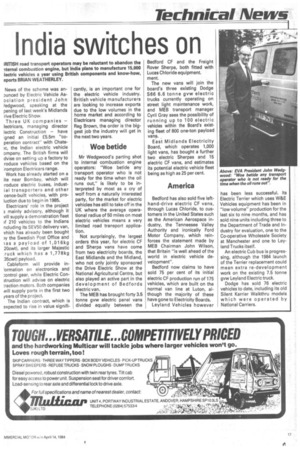India switches on
Page 19

If you've noticed an error in this article please click here to report it so we can fix it.
IRITISH road transport operators may be reluctant to abandon the nternal combustion engine, but India plans to manufacture 15,000 lectric vehicles a year using British components and know-how, eports BRIAN WEATHERLEY.
News of the scheme was anounced by Electric Vehicle Asociation president John tedgwood, speaking at the pening of last week's Midlands rive Electric Show.
Three UK companies — lectricars, managing director lectric Construction — have igned an initial £5.5m "coperation contract" with Chatem, the Indian electric vehicle ompany. The British firms will dvise on setting up a factory to roduce vehicles based on the :rompton Electricars range.
Work has already started on a ite near Bombay, which will 'reduce electric buses, Industial transporters and other cence-built vehicles, with proluction due to begin in 1985.
Electricars' role in the project s mainly advisory, although it viii supply a demonstration fleet yf 210 vehicles to the Indians ncluding its SEV50 delivery van, vhich has already been bought )‘,/ the Swedish Post Office and as a payload of 1,0 1 6kg 20cwt), and its larger Majestic .ruck which has a 1,77 8kg 35cwt) payload.
Cableform will provide in'ormation on electronics and ....ontrol gear, while Electric Construction will advise on electric traction motors. Both companies will supply parts in the first two years of the project.
The Indian contract, which is expected to rise in value signifi
cantly, is an important one for the electric vehicle industry. British vehicle manufacturers are looking to increase exports due to the low volumes in the home market and according to Electricars managing director Reg Brown, the order is the biggest job the industry will get in the next two years.
Woe betide
Mr Wedgwood's parting shot to internal combustion engine operators: "Woe betide any transport operator who is not ready for the time when the oil runs out," is likely to be interpreted by most as a cry of wolf from a naturally interested party, for the market for electric vehicles has still to take off in the UK where the average operational radius of 50 miles on most electric vehicles means a very limited road transport application.
Not surprisingly, the largest orders this year, for electric CF and Sherpa vans have come from two electricity boards, the East Midlands and the Midland, who not only jointly sponsored the Drive Electric Show at the National Agricultural Centre, but also played an active part in the development of Bedfords electric van.
The MEB has brought forty 3.5 tonne gvw electric panel vans divided equally between the Bedford CF and the Freight Rover Sherpa, both fitted with Lucas Chloride equipment.
ment.
The new vans will join the board's three existing Dodge S66 6.6 tonne gvw electric trucks currently operating on street light maintenance work, and MEB transport manager Cyril Gray sees the possibility of running up to 100 electric vehicles within the Board's existing fleet of 800 one-ton payload vans.
East Midlands Electricity Board, which operates 1,000 light vans, has bought a further two electric Sherpas and 15 electric CF vans, and estimates its potential electric vehicle fleet being as high as 25 per cent.
America
Bedford has also sold five lefthand-drive electric CF vans, through Lucas Chloride, to customers in the United States such as the American Aerospace industry, the Tenneesee Valley Authority and ironically Ford Motor Company, which reinforces the statement made by MEB Chairman John Wilson, that Britain "is well ahead of the world in electric vehicle development".
Bedford now claims to have sold 75 per cent of its initial electric CF production run of 175 vehicles, which are built on the normal van line at Luton, although the majority of these have gone to Electricity Boards.
Leyland Vehicles however has been less successful. Its Electric Terrier which uses W&E Vehicles equipment has been in "low volume" production for the last six to nine months, and has sold nine units including three to the Department of Trade and Industry for evaluation, one to the Co-operative Wholesale Society at Manchester and one to Leyland Trucks itself.
An electric Cub bus is progressing, although the 1984 launch of the Terrier replacement could mean extra re-development work on the existing 7.5 tonne gvw Leyland Electric truck.
Dodge has sold 76 electric vehicles to date, including its old Silent Karrier Walkthru models which were operated by National Carriers.




























































































